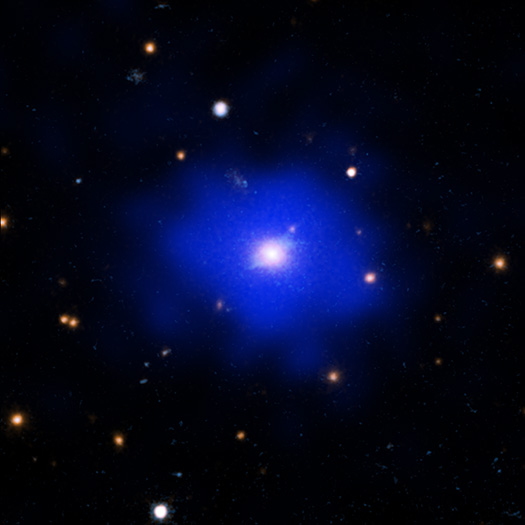For Release: July 20, 2023
NASA/CXC

Credit: X-ray: NASA/CXC/MIT/M. Calzadilla; UV/Optical/Near-IR/IR: NASA/STScI/HST; Image processing: N. Wolk
Press Image, Caption, and Videos
Astronomers have discovered the most distant “relaxed” galaxy cluster to date – the farthest cluster ever spotted that is not being disrupted by violent collisions with other clusters of galaxies. This finding is paving the way to learning how and when some of these gigantic structures form and why the universe looks like it does in the present day.
To find this distant and young galaxy cluster, teams of scientists used data from NASA’s Chandra X-ray Observatory, NASA’s retired Spitzer Space Telescope, the National Science Foundation/Department of Energy’s South Pole Telescope, and the Dark Energy Survey project in Chile. They reported the results in a series of three papers.
This galaxy cluster, called SPT-CL J2215-3537 (SPT2215 for short), is about 8.4 billion light-years from Earth, and is seen when the universe is only 5.3 billion years old, compared to its current age of 13.8 billion years. This implies that SPT2215 got a head start in its formation compared to other clusters of similar size, and that it has been “coasting” for the last billion years, allowing it to relax. Astronomers estimate the cluster has a mass some 700 trillion times that of the Sun.
Galaxy clusters are collections of dozens to hundreds of galaxies along with huge amounts of hot gas and dark matter filling the space between galaxies, all held together by gravity. This gas – which has a temperature of millions of degrees and radiates in X-rays – can act as a tracer of what is happening to the cluster.
Galaxy clusters grow over time by merging with other galaxy clusters or groups, causing disturbances in the cluster’s gas such as asymmetries or sharp features. Given enough time to “relax” without a merger, however, the gas can take on a smooth, calm appearance.
“Up until now, we have not seen a relaxed galaxy cluster as distant as SPT2215,” said Michael Calzadilla of the Massachusetts Institute of Technology (MIT), lead author of the most recent of the three papers, which confirmed the cluster to be relaxed and reports other key properties of the cluster.
In the middle of SPT2215 is a large galaxy containing a giant black hole in its center. The paper by Calzadilla discovered tremendous amounts of new stars forming in this large galaxy. The formation of stars in a cluster’s central galaxy is fueled by the cooling of the hot gas when a cluster becomes relaxed.
How quickly the gas cools to form stars is influenced by the behavior of the giant black hole in the center of the cluster. If the black hole drives too many powerful outbursts, then most of the gas in the cluster is prevented from cooling enough to form a flood of new stars. Unlike most relaxed clusters observed with Chandra, the giant black hole in SPT2215 does not appear to be preventing such cooling.
“It seems like the black hole in SPT2215 is quiet enough to let star formation flourish,” said Michael McDonald, also of MIT, who is a co-author of all three papers.
Another key feature of SPT2215 is the isolation of its central galaxy. There are no other galaxies within about 600,000 light-years that are anywhere near as bright or extended. This implies that the cluster has not experienced a merger with another cluster in about the last billion years, giving another piece of evidence that SPT2215 is relaxed.
Scientists were not sure they would find a galaxy cluster that was relaxed at this epoch of the universe, because they are usually still undergoing the turmoil of mergers with other clusters or groups of galaxies as they increase in size.
“The fact that this cluster is so massive, so early in the universe suggests a really exciting, fast formation history,” said Lindsey Bleem of the U.S. Department of Energy’s Argonne National Laboratory in Lemont, Illinois, whose team first reported spotting the cluster in 2020, in the first of the three papers. “Yet the fact that it is relaxed suggests the opposite. It would be like finding a tidy kitchen right after the dinner rush.”
These results on SPT2215 fit well with those of NASA’s James Webb Space Telescope, which has shown galaxies forming at a very young age.
“Relaxed clusters like SPT2215 are one of the signposts that have been used to measure the expansion of the universe,” said Adam Mantz of Stanford University, who first reported SPT2215’s relaxed status using Chandra data in 2022, in the second paper. "Adding distant objects like this to our sample of relaxed clusters allows us to better constrain the acceleration of the cosmic expansion, and the properties of the dark energy that drives it."
The recent paper by Calzadilla and his colleagues was published in the April 20, 2023, issue of The Astrophysical Journal. The paper led by Bleem was published in the March 2020 issue of The Astrophysical Journal Supplement Series. The paper led by Mantz was published in the February 2022 issue of Monthly Notices of the Royal Astronomical Society, and a preprint is available online.
NASA's Marshall Space Flight Center manages the Chandra program. The Smithsonian Astrophysical Observatory's Chandra X-ray Center controls science operations from Cambridge, Massachusetts, and flight operations from Burlington, Massachusetts.
Media Contact:
Megan Watzke
Chandra X-ray Center, Cambridge, Massachusetts
617-496-7998
mwatzke@cfa.harvard.edu
Jonathan Deal
Marshall Space Flight Center, Huntsville, Alabama
256-544-0034
jonathan.e.deal@nasa.gov


